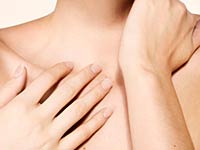
Jonathan Knowles
Problem No. 1: Tendinitis
The lowdown
Tendinitis occurs when tendons, which attach muscle to bone, get inflamed or irritated. In the hand, it's especially common at the base of your thumb, a condition called DeQuervain's tendinitis, says Steven Beldner, MD, an assistant professor of orthopedic surgery at the Albert Einstein Medical School in New York City. "We often see this in pregnant or perimenopausal women," he says. "Synovium—the thin soft-tissue layer that covers and lubricates your tendons—has estrogen receptors in it, so when your hormones fluctuate, it can swell." Repetitive stress injuries from excessive texting can also cause DeQuervain's, informally known as BlackBerry thumb. "Your thumb is the most dexterous part of your hand, so it's more prone to strain," explains Stuart Elkowitz, MD, an orthopedic hand surgeon in Mount Kisco, New York.
What it feels like
Burning pain on the thumb side of your wrist that can travel up your forearm and worsens when grasping objects or twisting your wrist. You may also notice swelling and numbness.
The Rx
About 90 percent of the time, the problem goes away after a few days of avoiding pain-causing activities, using an over-the-counter splint to stabilize your wrist and tendons, and taking an OTC anti-inflammatory such as Advil. (If you really can't stop texting, limit yourself to yes/no answers!) If you don't get better in a week, your doctor may refer you to a physical therapist or to an orthopedic specialist, who can administer cortisone shots to reduce pain and swelling.
Problem No. 2: Carpal tunnel syndrome
The lowdown
The carpal tunnel is formed by the bones of your wrist and the transverse carpal ligament. This tunnel protects the median nerve—which supplies feeling and movement to parts of the hand—as well as the flexor tendons, which bend your fingers and thumb. Carpal tunnel syndrome itself occurs when the synovium surrounding the flexor tendons swells, putting pressure on your median nerve. Women are approximately three times more likely than men to develop the condition, Dr. Rohde says, which can frequently occur during pregnancy, perimenopause, and even while using birth control pills. You're also at greater risk if you suffer from a thyroid disorder or diabetes—both conditions that make tendons more susceptible to inflammation.
What it feels like
Tingling and numbness in your whole hand. "You may notice that you have trouble buttoning your shirt or putting in earrings," Dr. Rohde says. Since many people sleep with their wrists curled, which puts strain on the carpal tunnel, symptoms may worsen at night and even wake you up.
The Rx
Carpal tunnel can usually be detected by a simple physical exam, but your doctor may also want to test your median nerve function (it's done with little needles) to see how much it's being compressed. About 75 percent of cases can be reversed after six weeks of wrist splints and cortisone shots, research shows; otherwise, you may need surgery. It's done on an outpatient basis under local anesthesia and consists of cutting the carpal ligament to enlarge the carpal tunnel. You may have pain and swelling for two weeks, but then the problem should be gone.
Problem No. 3: Osteoarthritis
The lowdown
More than a quarter of women will develop osteoarthritis—a condition in which the cartilage that covers the bone surfaces at your joints begins to erode—in their hands. "We see it at the base of the thumb and the fingertips as early as your 40s," says Michelle Carlson, MD, an orthopedic surgeon at The Hospital for Special Surgery in New York City. Women are more susceptible to this type of arthritis than men because they have looser joints and ligaments, which allows thumbs to move more and cartilage to wear out faster.

Jonathan Knowles
Aching or pain that worsens after gripping or grasping; also stiffness in the morning or during rainy weather.
The Rx
See your doctor, who may suggest splints, cortisone shots, anti-inflammatories, and exercises. You'll also have to modify your habits. "Holding free weights at the gym can be irritating, for instance," Dr. Carlson says. "So can activities such as weeding." If none of this helps, talk to your doc about surgery to fuse or remove the painful joint.
Problem No. 4: Ganglion cysts
The lowdown
Ganglion cysts are fluid-filled sacs that grow out of a joint—like a balloon on a stalk—either on the top or the underside of your wrist. They represent anywhere from 50 to 70 percent of soft-tissue lumps on the hands and wrist and are three times more common in women than men. It's not really known what causes them, although some may be related to trauma, such as falling on an outstretched hand.
What it feels like
Usually they're painless, but occasionally they can put pressure on the nerves that pass through the joint, causing a burning pain.
The Rx
This harmless cyst may eventually disappear on its own. But if it's painful or the appearance bothers you, then your doctor can remove it through surgery under local anesthesia. "That's the best way to get rid of it, with the lowest chance of recurrence," Dr. Rohde says.
